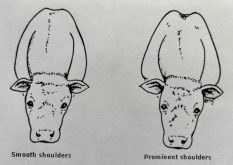One of the most frustrating conditions to hit our herd sires is testicular degeneration (testicles shrinking up). It often strikes without warning or reason. It causes headaches for both purebred breeders with bulls they have sold and for insurance companies with bulls they have insured.
In this article I will go over some known causes and what to watch for. Often we cannot prevent this condition; however, early recognition of warning signs may prevent the economic ramifications it brings.
The scrotum and its muscular attachments has the ability to expand and contract, and in so doing raise and lower the testicles depending on the ambient temperature and body temperature of the bull. The scrotal temperature is normally lower than body temperature and must be maintained at that for normal sperm production. Anything that alters this greatly will affect normal sperm production and could over the long-term lead to testicular degeneration. It is important to note when even a temporary increase in scrotal temperature (say 1 C for 10 days) will affect sperm production for four to five months. Recovery will take a long time, which is a luxury you, as a producer, do not often have.
Read Also

Building demand together: The impact of Canada’s beef import levy
The beef import levy has become a central tool for ensuring balance in Canada’s beef industry
Any condition, which causes increased temperature in the scrotal area, must be guarded against. Severe clinical disease, swelling in the area as a result of trauma such as when a bull’s scrotum is stepped on or bunted or testicular torsion may result in degeneration over time.
Extremely fat bulls have too much insulation in their scrotum which raises the internal temperature. Frostbite will initially cause damage due to freezing but as healing occurs inflammation can occur and cause the temperature to rise in these tissues.
Most of these conditions may have occurred some time earlier and may not have even been recognized until the testicular degeneration is picked up on a semen evaluation.
The body also has a unique mechanism when it comes to the testicles. Any situation where sperm mix into the bloodstream causes the equivalent of organ rejection. The bull’s body produces antisperm antibodies, which fight sperm production causing the testicles to degenerate. This could be triggered by any traumatic incident or a testicular torsion. If surgery is necessary to remove a damaged testicle, and precautions are not taken, the remaining testicle could degenerate due to either inflammation or sperm getting into the bull’s blood supply.
There is a huge misconception out there that treating a bull with antibiotics will hurt sperm production. It is far, far worse to leave a medical condition untreated and run the risk of an increased body temperature rather than quickly treating the condition. Having said that, treatment with anabolic steroids or implanting can have devastating effects on the testicles because of the alteration in hormone production.
Degeneration can happen to any bull at any stage in its life. That’s why it’s important to semen test close to the breeding season in case anything has gone undetected over the winter. Degenerating testicles feel a lot softer and will measure much smaller than they did before. Sometimes only one testicle will degenerate such as from a bunt to only one side of the scrotum. If the other testicle is fully functional you will even see it get bigger and it may produce more sperm to compensate for the loss of the other testicle. These bulls have somewhat reduced capacity but still may be fertile enough to use.
The most obvious clinical signs of degeneration, of course, are shriveled testicles and often the scrotal hair will grow longer.
If you suspect degeneration, or if the testicles are markedly swollen or frostbitten, it is wise to have a semen evaluation performed. As mentioned before, regeneration can take place but it is rare. It also may take several months to occur and depending on the time of year you may not be able to afford the time.
Anytime bulls are fighting excessively or you notice even slightly swollen testicles document it, especially if the bull is insured. Insurance companies need some form of documentation because testicular degeneration is such a grey area, primarily because we often don’t know what’s causing it.
Spontaneous degeneration can occur at any time in a bull’s life but is more common in older bulls greater than five years old. That is why it is imperative to semen test all older bulls every year.
When you have a past record of scrotal size it is easier to pick up degeneration in the early stages and eliminate the bull. It’s not uncommon for scrotal size to vary up to two cm, depending on fat cover and season of year. An experienced veterinarian will also pick up the palpable softness along with the multitude of primary sperm defects that accompany degenerating testicles.
Testicles are one of the most important organs when it comes to breeding ability and fertility so it always makes sense to keep a close eye on this investment and eliminate any degenerating bulls before they disrupt your breeding program.
This article was first published at AGCanada.com.
















